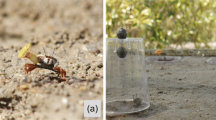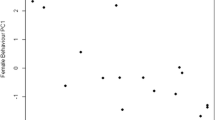Abstract
The fiddler crab Uca perplexa has a conspicuous male courtship signal that is directed at females to attract them to the male’s burrow for mating. The signal involves waving the unflexed large claw up and down. To determine whether the spatiotemporal structure of the wave is under selection by female choice, we examined whether females had a preference for any particular features of the wave. Females respond to a waving display by either visiting the male’s burrow entrance or by electing to pass without visiting the burrow. We filmed mate-searching females and the waving males that they visited or passed. We documented the wave structure of these males using frame-by-frame analysis. Males produce a two-part wave with component A preceding component B. Both components have an upstroke, a pause at the apex and a downstroke. The tip of the claw was raised much higher in B than in A. Visited males had a shorter delay between the two wave components than did males that the females passed without visiting. Visited males also produced component B waves that had a slower upstroke than those of passed males. There was a significant correlation between the relative height of the raised claw and the duration of the upstroke of component B. Females were selecting males that raised their major claw to the highest position (two to three times as high as the carapace width). Passed males brought down their major claw earlier and from a lower position than did visited males. The data suggests that wave structure has evolved through female choice. Male display rate and body size were not female choice cues. An earlier study showed that display duration was also not used by females in selecting mates.



Similar content being viewed by others
References
Andersson S (1989) Sexual selection and cues for female choice in leks of Jackson’s widowbird Euplectes jacksoni. Behav Ecol Sociobiol 25:403–410
Andersson MB (1994) Sexual selection. Princeton University Press, Princeton
Backwell PRY, Passmore NI (1996) Time constraints and multiple choice criteria in the sampling behaviour and mate choice of the fiddler crab, Uca annulipes. Behav Ecol Sociobiol 38:407–416
Backwell PRY, Jennions MD, Passmore NI, Christy JH (1998) Synchronized courtship in fiddler crabs. Nature 391:31–32
Backwell PRY, Jennions MD, Christy JH, Passmore NI (1999) Female choice in the synchronously waving fiddler crab Uca annulipes. Ethology 105:415–421
Bischoff RJ, Gould JL, Rubenstein DI (1985) Tail size and female choice in the guppy (Poecilia reticulata). Behav Ecol Sociobiol 17:253–255
Bradbury JW, Vehrencamp SL (1998) Principles of animal communication. Sinauer, Sunderland
Christy JH, Backwell PRY, Goshima S, Kreuter T (2002) Sexual selection for structure building by courting male fiddler crabs: an experimental study of behavioral mechanisms. Behav Ecol 13:366–374
Clutton-Brock TH, Guinness FE, Albon SD (1982) Red deer. Behavior and ecology of two sexes. University of Chicago Press, Chicago
Crane J (1975) Fiddler crabs of the world. Ocypodidae: genus Uca. Princeton University Press, Princeton
Cresswell W (1994) Song as a pursuit-deterrent signal, and its occurrence relative to other anti-predation behaviours of skylark (Alauda arvensis) on attack by merlins (Falco columbarius). Behav Ecol Sociobiol 34:217–223
deRivera CE (2005) Long searches for male-defended breeding burrows allow female fiddler crabs, Uca crenulata, to release larvae on time. Anim Behav 70:289–297
FitzGibbon CD, Fanshawe JH (1988) Stotting in Thomson’s gazelles: an honest signal of condition. Behav Ecol Sociobiol 23:69–74
Frith CB, Beehler BM (1998) The birds of paradise, Paradisaeidae. Oxford University Press, Oxford
Gerhardt HC (1991) Female mate choice in treefrogs: static and dynamic acoustic criteria. Anim Behav 42:615–635
Gibson RM, Bradbury JW (1985) Sexual selection in lekking sage grouse: phenotypic correlates of male mating success. Behav Ecol Sociobiol 18:117–123
von Hagen HO (1983) Visual and acoustic display in Uca mordax and U. burgersi, sibling species of neotropical fiddler crabs. I. Waving display. Behaviour 83:229–250
Hebets EA, Uetz GW (1999) Female responses to isolated signals from multimodal male courtship displays in the wolf spider genus Schizocosa (Araneae: Lycosidae). Anim Behav 57:865–872
Karino K (1995) Male–male competition and female mate choice through courtship display in the territorial damselfish Stegastes nigricans. Ethology 100:126–138
Kennedy CEJ, Endler JA, Poynton SL, McMinn H (1987) Parasite load predicts mate choice in guppies. Behav Ecol Sociobiol 21:291–295
Knapp RA, Kovach JT (1991) Courtship as an honest indicator of male parental quality in the bicolor damselfish, Stegastes partitus. Behav Ecol 2:295–300
Kodric-Brown A, Nicoletto PF (2001) Female choice in the guppy (Poecilia reticulata): the interaction between male color and display. Behav Ecol Sociobiol 50:346–351
Krebs JR, Dawkins R (1984) Animal signals: mind-reading and manipulation. In: Krebs JR, Davies NB (eds) Behavioural ecology: an evolutionary approach, 2nd edn. Blackwell Scientific Publications, Oxford, pp 380–402
Kruijt JP, de Vos GJ (1988) Individual variation in reproductive success in male black grouse, Tetrao tetrix L. In: Clutton-Brock TH (ed) Reproductive success: studies of individual variation in contrasting breeding systems. University of Chicago Press, Chicago, pp 279–290
Land M, Layne J (1995) The visual control of behaviour in fiddler crabs I. Resolution, thresholds and the role of the horizon. J Comp Physiol [A] 177:81–90
Manning A, Dawkins MS (1998) An introduction to animal behaviour, 5th edn. Cambridge University Press, Cambridge
Matsumasa M, Murai M (2005) Changes in blood glucose and lactate levels of male fiddler crabs: effects of aggression and claw waving. Anim Behav 69:569–577
McClintock WJ, Uetz GW (1996) Female choice and pre-existing bias: visual cues during courtship in two Schizocosa wolf spiders (Araneae: Lycosidae). Anim Behav 52:167–181
McDonald DB (1989) Correlates of male mating success in a lekking bird with male–male cooperation. Anim Behav 37:1007–1022
Murai M, Backwell PRY (2005) More signalling for earlier mating: conspicuous male claw waving in the fiddler crab, Uca perplexa. Anim Behav 70:1093–1097
Nakasone Y, Murai M (1998) Mating behavior of Uca lactea perplexa (Decapoda: Ocypodidae). J Crustac Biol 18:70–77
Payne RJH, Pagel M (1997) Why do animals repeat displays? Anim Behav 54:109–119
Petrie M, Halliday T, Sanders C (1991) Peahens prefer peacocks with elaborate trains. Anim Behav 41:323–331
Pfennig KS (1998) The evolution of mate choice and the potential for conflict between species and mate-quality recognition. Proc R Soc Lond B 265:1743–1748
Salmon M (1965) Waving display and sound production in the courtship behavior of Uca pugilator, with comparisons to U. minax and U. pugnax. Zoologica 50:123–150
Salmon M (1967) Coastal distribution, display and sound production by Florida fiddler crabs (genus Uca). Anim Behav 15:449–459
Salmon M, Ferris SD, Johnston D, Hyatt G, Whitt GS (1979) Behavioral and biochemical evidence for species distinctiveness in the fiddler crabs, Uca speciosa and U. spinicarpa. Evolution 33:182–191
Sigmund WR (1983) Female preference for Anolis carolinensis males as a function of dewlap color and background coloration. J Herpetol 17:137–143
Vinnedge B, Verrell P (1998) Variance in male mating success and female choice for persuasive courtship displays. Anim Behav 56:443–448
Tinbergen N (1951) The study of instinct. Oxford University Press, New York
Zahavi A (1977) Reliability in communication systems and the evolution of altruism. In: Stonehouse B, Perrins C (eds) Evolutionary ecology. Macmillan, London, pp 253–259
Zeil J, Al-Mutairi MM (1996) The variation of resolution and of ommatidial dimensions in the compound eyes of the fiddler crab Uca lactea annulipes (Ocypodidae, Brachyura, Decapoda). J Exp Biol 199:1569–1577
Acknowledgements
We are grateful to Yasuo Fukui and Yukio Nakasone for helpful discussions. We thank Shigeo Nakamura and Yoshikatsu Nakano for their technical support and three anonymous referees for comments on the manuscript. This work was supported by a research grant from University of the Ryukyus. The experiments comply with the current laws in Japan.
Author information
Authors and Affiliations
Corresponding author
Additional information
Communicated by T. Czeschlik
Rights and permissions
About this article
Cite this article
Murai, M., Backwell, P.R.Y. A conspicuous courtship signal in the fiddler crab Uca perplexa: female choice based on display structure. Behav Ecol Sociobiol 60, 736–741 (2006). https://doi.org/10.1007/s00265-006-0217-x
Received:
Revised:
Accepted:
Published:
Issue Date:
DOI: https://doi.org/10.1007/s00265-006-0217-x




